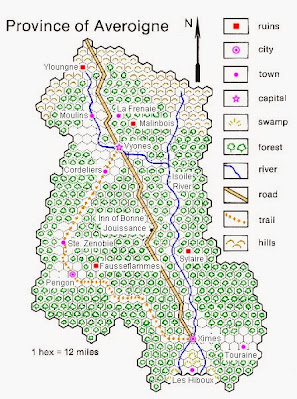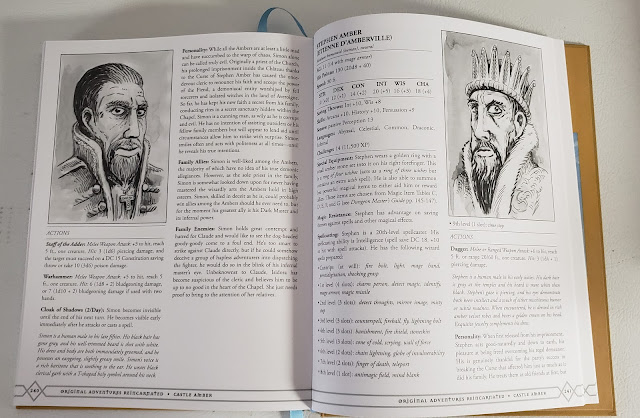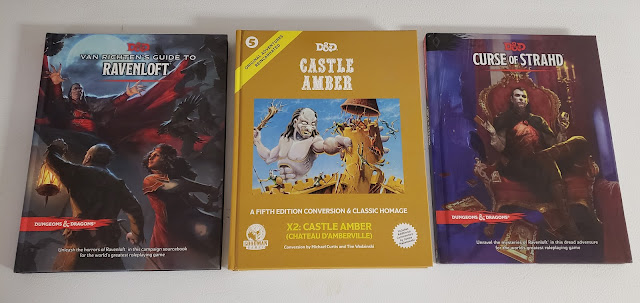The gaming magazine is dead. After all, when was the last time that you were able to purchase a gaming magazine at your nearest newsagent? Games Workshop’s White Dwarf is of course the exception, but it has been over a decade since Dragon appeared in print. However, in more recent times, the hobby has found other means to bring the magazine format to the market. Digitally, of course, but publishers have also created their own in-house titles and sold them direct or through distribution. Another vehicle has been Kickststarter.com, which has allowed amateurs to write, create, fund, and publish titles of their own, much like the fanzines of Kickstarter’s ZineQuest. The resulting titles are not fanzines though, being longer, tackling broader subject matters, and more professional in terms of their layout and design.
—oOo—

Most magazines for the roleplaying hobby give the gamer support for the game of his choice, or at the very least, support for the hobby’s more popular roleplaying games. Whether that is new monsters, spells, treasures, reviews of newly released titles, scenarios, discussions of how to play, painting guides, and the like… That is how it has been all the way back to the earliest days of
The Dragon and
White Dwarf magazines.
Wyrd Science is different—or at least, the very first issue is very different. Its bright and breezy, pastel-shaded pages features not a single monster, spell, treasure, review, scenario, or the like. Instead, its ninety odd pages contain some eighteen entries—divided between ‘Common Items’ and ‘Rare Items’—consisting of columns and retrospectives, along with a slew of interviews with just a handful of some of the hobby’s creators and commentators.
Wyrd Science Session Zero—actually the first issue, but misnomered to confuse everyone—was published by
Best in Show in January, 2021 , following a successful
Kickstarter campaign. The strand that runs throughout the issue is that the year 2020 has been terrible (which is certainly true), but what is interesting about 2020 is how we as gamers have adapted to the adversity and changed to deal with the challenge of not being able to game together. In the opening diary entry of ‘Quickstart – Manga’s Musings’, Mira notes our shift to online gaming, how there continued to be new content to support our hobby, and that despite the difficult conditions, publishers such as Wizards of the Coast and Games Workshop were even more successful. This is something that John Power, the editor of
Wyrd Science, will return to later in the issue with ‘2020 Vision’ with his own appraisal of the year just gone, along with his note about the growing diversity amongst the creators and players of games of all types. Anna Maxwell looks at another trend from the last year ‘Quickstart – Alone In The Dark’, which is that of solo play. There has always been a solo aspect to the hobby with long running series of
Fighting Fantasy books and
Tunnels & Trolls solo adventures, but a newer trend has seen the rise of roleplaying games specifically written to be played solo, often in the journal format. The title which has got all of the attention is Tim Hutchings’
Thousand Year Old Vampire, an exploration of alienation and loss as with a few rolls of the dice the player determines events and charts his vampire’s responses to them from his transformation into the undead until his final death. It is the nearest that
Wyrd Science Session Zero gets to a review, but it is clear that no what your experience of the last year was,
Thousand Year Old Vampire is possibly one of the most thematically appropriate roleplaying games to be published in 2020.
Fans of the Old School—Renaissance or otherwise, will doubtless enjoy ‘Quickstart – Publish And Be Damned’ and ‘Quickstart – Cast Pod!’. The former is an interview with Andre Novoa of Games Omnivorous, which released a surprising number of titles in 2020. As well as discussing some of those titles, including the well-received
Mausritter and the Manifestus zines—
Cabin Risotto Fever,
The Feast on Titanhead, and
The Seed, the interview discusses the production values which the publisher has become known for. What notable here is that the publisher does not use traditional roleplaying designers as part of its production, in fact, designers who do not roleplay at all. It is an enjoyable interview as is the latter. This is with Dirk the Dice of the
Grognardfiles RPG Podcast. The interview covers the origins and history of the podcast, and for listeners of the podcast, there is much here that will be familiar, as much of this story has been told via episodes of the podcast. However, for anyone who has never listened, this is a good introduction. Only fifty episodes to catch up on, but enjoyable they are too. The Grognardfiles RPG Podcast is not the only British podcast given space in
Wyrd Science Issue Zero. In ‘Zoom Of Horrors – The Smart Party On Gaming Online In 2020’, the hosts of
What Would the Smart Party Do? explain how they adapted to playing online in 2020—quite easily it would seem—and how it came to dominate much of their social life and how they coped with so many roleplaying games competing for their attention.
“THE LIFEBLOOD OF OUR COMMUNITY, good gaming clubs are a home away from home.” is the opening line of ‘Quickstart – Roll Deep’, an interview with Sasha Bilton of H.A.T.E. (Hackney Area Tabletop Enthusiasts) about his ‘local’ gaming club. The role of clubs cannot be underestimated, but it is debatable as to whether their role is quite as important as the title of the article suggests, especially after the last year of almost everyone having moved online to play. In effect, the article straddles 2020 though and is far from relevant in a year when we were all playing online, and perhaps the issue should have focused more on that rather than on something which nobody knows if and when it will be possible again. Nevertheless, it throws a spotlight on what sounds to have been—and should be again, a well-run and vibrant gaming club.
Wyrd Science does not restrict its content to just roleplaying. In ‘Table For One – Matt Thrower Embraces Solo Gaming’ continues the issue’s theme about solo gaming, not roleplaying though, but board games. Of course, it mentions
Pandemic, but it looks at other titles too and points out that solo options are becoming a regular design feature in the creation of boardgames. ‘Meeple Hold On – Dan Jolin Finds Solace In Board Games’ explores a similar vein, but extends the play of boardgames online as with the play of roleplaying games moving online. However, whilst the author can, “…[F]irmly believe that you can never be bored as long as you have board games in your house.”, he cannot escape regurgitating a cliché that was tired ten years ago and is dead, dead in 2020, let alone 2021. At what point will writers about boardgames stop trotting out something along the lines of, as the author does here, “Thanks to a recent resurgence of the board game hobby and industry, those shelves need no longer limit you to, say, the roll-and-move slog of
Monopoly, or the dragged-out, dice-dependent conquesting of
Risk.”? It shows a complete lack of awareness of both the hobby and the market, and to be clear, board games have been growing in popularity for the last two decades at least, and there is no such resurgence and if so, it is certainly not recent. What next, comics are no longer just for kids?
The status of wargaming and miniatures is featured in ‘A Miniature Renaissance – Chris Mcdowall Scouts Out The Future Of Wargames’, written by the designer of
Into the Odd and
Electric Bastionland, suggesting that even as the success of Games Workshop grows, there is a movement in the hobby towards simplicity combined with fewer restrictions in terms of miniatures brought to the table. ‘Model Behaviour – Luke Shaw On Building Miniature Communities’ looks at the other side of the wargaming and miniatures hobby, and that is painting. This is no tutorial though, but instead discusses where to go online to discover more about painting your miniatures and the community which has built up around the hobby online. It nicely casts that hobby in a new light.
As well as reflecting the shift in the hobby from face-to-face to online gaming,
Wyrd Science also reflects the shift in diversity with series of articles on Queer and disabled gaming, women in gaming, and non-Western gaming. Together, ‘Beyond Violence – Jay Dragon On The Queer Future Of TTRPG Design’, ‘Sisters Of Battle – Danie Ware On The Changing Face Of Fantasy’—with an emphasis on fiction slightly more than gaming, and ‘Making Waves – Pamela Punzalan On The Rise Of RPGSEA’ respectively give room for voices that might not otherwise be heard in a traditional gaming magazine. The latter article is particularly interesting in that it is rare to hear about gaming and gaming culture outside of the English-dominated market. All three are to be welcomed though, and hopefully future issues of the magazine will provide a platform for other voices and opinions too, as these are all good articles.
A similar shift in diversity in terms of subject matter in the hobby is echoed in two other interviews in the issue. One is ‘Phantoms Of Oppression’ is with Banana Chan, the co-designer and co-publisher of Wet Ink Games’
Jiangshi – Blood In The Banquet Hall. This roleplaying game combines Chinese food with unknown horrors against the backdrop of racism and oppression, the Player Characters running their family Chinese restaurant by day and stopping actual monsters terrorising their neighbourhood by night. The other is ‘Home On The Strange’, an interview with Chris Spivey of Darker Hue Studios about his award-winning
Harlem Unbound—one of the best supplements of 2017—and his forthcoming Haunted West, which presents a Weird West roleplaying game against the backdrop of continued post-American Civil War Reconstruction, rather than discontinued Reconstruction. Again, these are lengthy pieces which showcase how the hobby can explore some of history’s difficult issues.
The continuing growth in the popularity of more traditional and Scandinavian roleplaying games is placed under the spotlight with another pair of interviews. Simon Stålenhag’s artwork has not only inspired two roleplaying games—
Tales from the Loop and
Things from the Flood, but also captured our imaginations with his artbooks which juxtapose outré technology—rusting robots and hovering container ships—with the ordinary everyday life to be found in the Swedish suburbs. The artwork is fascinating, the viewer able to see the odd nature of each scene, know that the people within it accept this as the norm. He is interviewed in ‘Mazes & Monsters’, exploring his inspirations and how his cinematic visions have been adapted in both the televisual and roleplaying mediums. It only hints at what is to come in the next book, a more apocalyptic vision than has been seen to date, but the fans of his artwork will know that it will be worth the wait. Almost at the opposite to Simon Stålenhag’s clean visions is the Doom-laden Artpunk of the award-winning
MÖRK BORG, the pre-apocalypse Old School Renaissance roleplaying game. ‘The Apocalypse Meant Something’ is with its graphic designer, Johan Nohr, which examines how the look and feel of the roleplaying game does everything good graphic design should not and how that contributed to the game. Not only is this different, but it means that the interview is taking a different approach too, but still highlighting how the visual and the physical design has an impact on the design of the game itself.
The featured and longest interview in
Wyrd Science Session Zero is ‘The Man With The 20-Sided Brain’. This is with the author of the comics
The Wicked + the Divine and the
Dungeons & Dragons-cartoon inspired
DIE, roleplayer, ex-games journalist, and
Warhammer 40,000 comics author, Kieron Gillen. It is an enjoyable and informative read and makes you wonder what the author might do with a roleplaying game, but at least should make the reader want to go out find a copy of
DIE (of which there is a roleplaying game), if not
The Wicked + the Divine.
The contrasting strands of old and new—or at least the relatively old and relatively new—that run through
Wyrd Science Issue Zero are seen in two board games. The old is the
Escape The Dark... series of games, such as
Escape the Dark Castle and
Escape the Dark Sector, the solo-style boardgames which can be played by one or more players. These are heavily inspired by classic fantasy and Science Fiction, as well as the
Fighting Fantasy series of solo adventure books and consequently the interview with creator Thomas Pike in ‘The Dark Is Rising’ emphasises the stories created in playing either. The new is
Root, one of the biggest boardgames of the last few years, which layers its political elements under woodland and anthropomorphic animals, explored in ‘If You Go Down To The Woods Today’ and examines the different ways which faction is played and how that affects the game. Again, these are excellent articles which highlight just two elements of the board game hobby.
Physically,
Wyrd Science Session Zero is impressively bright and breezy. The layout is clean and tidy, with decent use of photographs against pieces of art as more like spot fillers. The issue does need another edit in places though.
Anyone coming to
Wyrd Science Session Zero expecting content for his favourite game will definitely be disappointed. The inaugural issue of the magazine is very much about the hobby—interviews and retrospectives, and similar—rather than for the hobby (or a particular game). In particular, the issue highlights just how much our hobbies—roleplaying, boardgaming, and miniatures gaming, have been forced to change and adapt in the last year, and us along with them. In doing so,
Wyrd Science Session Zero captures much of what our gaming has been like in 2020 with a series of entertaining and informative interviews. Just like all three of these hobbies covered in the issue, it will be just as interesting to see where
Wyrd Science Session Two goes...
—oOo—
The next issue of
Wyrd Science—actually marked ‘Issue Two’—is currently being funded on
Kickstarter.
 Name: Tales From Ye Dusty Olde Crap Shoppe
Name: Tales From Ye Dusty Olde Crap Shoppe




































